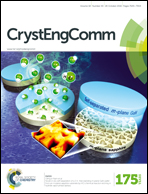NiCo2S4/carbon nanotube nanocomposites with a chain-like architecture for enhanced supercapacitor performance†
Abstract
A novel type of NiCo2S4/carbon nanotube (NCS/CNT) nanocomposite has been successfully prepared via a simple refluxing route without any surfactant and template. SEM and TEM observations confirm that the as-obtained NiCo2S4/CNT nanocomposites exhibit a necklace-like architecture, in which the NiCo2S4 particles are threaded with CNTs. As electrode materials for supercapacitors, the nanocomposites deliver an obviously pseudocapacitive behavior enhanced by a synergistic effect. When the loaded amount of CNTs is 10 mg (NCS/CNT-10), the maximum specific capacitance reaches up to 2210 F g−1 at 1 A g−1 and the specific capacitance can be maintained at 1949 F g−1 at 1 A g−1 after 14 000 multi-rate charge–discharge cycles. By applying the NCS/CNT-10 composite as the positive electrode and activated carbon as the negative electrode, an asymmetric supercapacitor was fabricated with excellent electrochemical performance. Such a large enhancement of the electrochemical performance is attributed to the strong necklace-like architectures, which possess advantages such as high electric conductivity, good mechanical stability and excellent strain accommodation.


 Please wait while we load your content...
Please wait while we load your content...